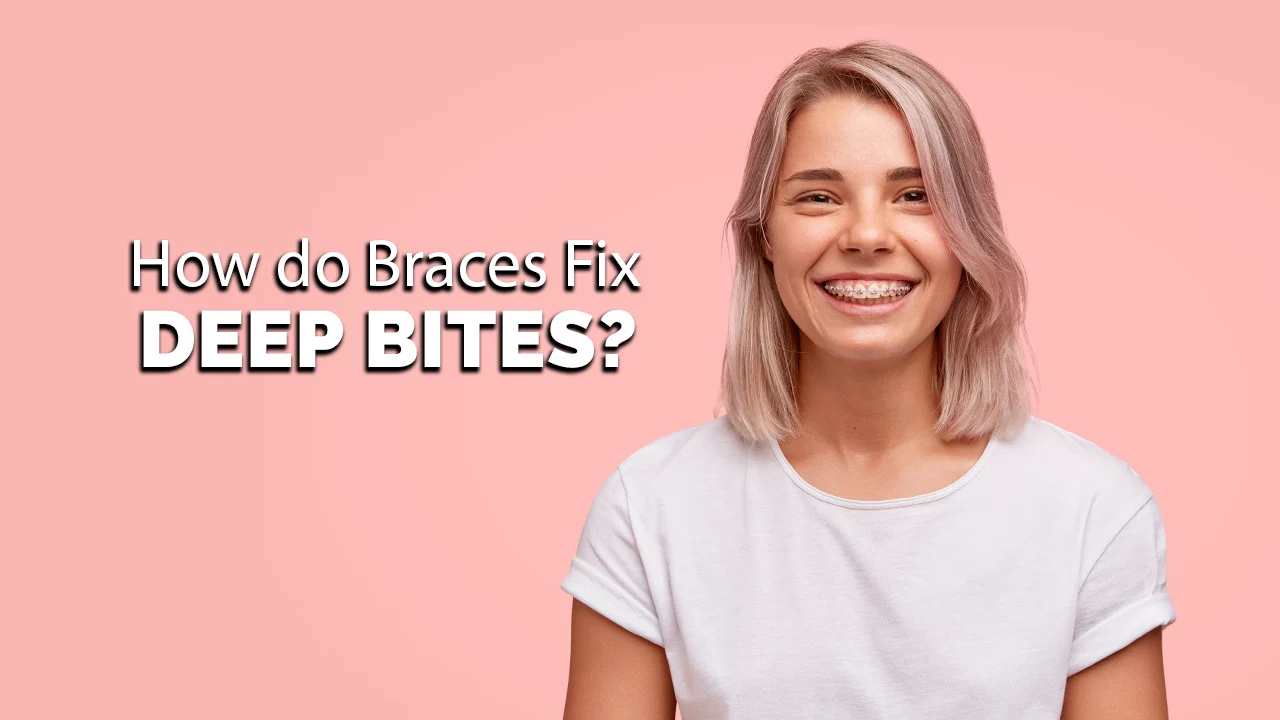
How Do Braces Fix Deep Bites?
By Dr. Tyler Coles – Premier Orthodontics
Table of Contents
Are you aware that approximately 15 to 20 percent of Americans have deep bites? A deep bite is a dental issue that can lead to a number of oral health problems if left untreated. In this article, we will explore what a deep bite is, its causes, the complications that may arise, and the various treatment options available to correct this common condition. So, if you’re ready to achieve a healthier and more confident smile, let’s dive in.
What Is A Deep Bite?
A deep bite, also known as a deep overbite, occurs when the upper teeth significantly overlap the lower teeth, sometimes even touching the roof of the mouth. This condition can negatively affect a person’s ability to speak, breathe, and chew efficiently. It may also alter the shape of one’s face, leading to a rounder, shorter, or more aged appearance, and can cause damage to the teeth and gums. Given that nearly 21.98% of individuals worldwide have deep bites, proactive treatment seeking is advisable.
The image below is an example of a deep bite:
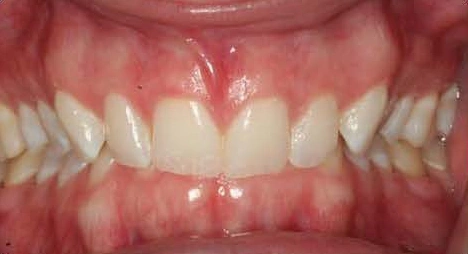
Diagnosing a deep bite involves a visual examination of the teeth and a bite assessment, especially in cases with crooked teeth. Treatment for deep bites may include braces, clear aligners, or a combination of these methods. Orthodontists may use different tools to help them in achieving desired results. It usually takes one to two years to correct deep bites, making early intervention particularly necessary, especially in young children.
Causes of Deep Bite
Potential causes of deep bites may include hereditary factors including genetics, a small jaw, a strong bite, and misalignment of the teeth and jaws are all hereditary factors that may contribute to a deep bite. Understanding these factors can help in developing a treatment plan to correct deep bites.
Poor jaw development may be caused by missing teeth, jaw injury, and misalignment of the teeth and jaws. When back teeth are missing, the teeth in the anterior region may move forward, deepening the bite and increasing the need for deep bite correction. By identifying the underlying cause of a deep bite, a tailored treatment plan can be created to address the issue effectively.
Normal Overbite vs. Deep Bite
A normal overbite is characterized by a slight overlap of the upper teeth over the lower teeth, typically measuring 1 to 2 mm. This slight overlap is considered ideal. However, a deep bite is an abnormal vertical overlap, wherein the teeth excessively overlap, with the upper front teeth excessively covering the lower front teeth when the back teeth are in occlusion.
The image below is an example of an ideal overbite:
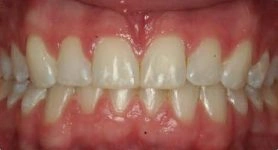
The difference between a normal overbite and a deep bite lies in the degree of overlap. While a normal overbite involves a slight overlap of the top teeth over the bottom teeth, a deep bite has a more significant overlap. The increased overlap in deep bites can result in various oral health problems, therefore seeking appropriate orthodontic treatment is recommended.
Complications of Untreated Deep Bite
If left untreated, a deep bite can have several negative consequences, including tooth damage, gum issues, and jaw and facial pain. Rectifying deep bites is vital not only for aesthetics but also for promoting oral health, improving function, reducing the risk of bruxism and enamel erosion, and enabling more comprehensive dental care.
Failing to treat deep bites can result in chronic issues that may require extensive dental intervention. Pursuing orthodontic treatment can help you avert these complications, leading to a healthier, more self-assured smile. Let’s delve deeper into the specific complications that may arise from untreated deep bites.
Tooth Damage
Untreated deep bites can lead to damage to the natural tooth enamel, the formation of mouth sores and ulcers, jaw pain, headaches, speech impediments, difficulties with chewing and biting, an increased risk of injury to the front upper teeth, tooth wear, and the potential for mouth injuries. Braces can be effective in addressing deep bites by applying pressure to the lower jaw to push it forward and the upper jaw backward, thus reducing the overlap of the teeth. This helps to reduce the risk of potential tooth damage and other complications associated with deep bites.
Watch the image below to see how untreated deep bites may lead to wear of the teeth:
There is also a potential risk of root resorption, which occurs when the roots of the teeth are weakened or destroyed due to the pressure of the braces. Additionally, there is a chance that the teeth may shift back to their original positions after the braces are removed. This makes wearing retainers after deep bite treatment essential for maintaining the corrected position of the teeth and preventing a recurrence of the deep bite.
Jaw and Facial Pain
An untreated deep bite can result in various problems, including:
Jaw pain
Headaches
Tooth wear
Speech impediments
Difficulty in chewing and swallowing
Fixing Mild Deep Bites With Braces & Bite Pads
Mild deep bites can be corrected by using a combination of braces and bite pads.
Early intervention in cases of deep bite, including closed bite and especially mild ones, is key to preventing the condition from progressing and the onset of more serious dental issues.
This patient shown below is a good example of a mild deep bite.

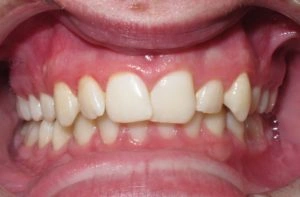
You can imagine that if we were to put braces on his top and bottom teeth, he would have a tendency to bite on top of the lower braces due to his deep bite.
In order to correct this type of deep bite during the braces process, a combination of braces and bite pads would need to be used.
Bite pads (sometimes called bite turbos) are small pads of dental composite that are placed on the teeth to prop the bite open and allow the safe and stable placement of braces.
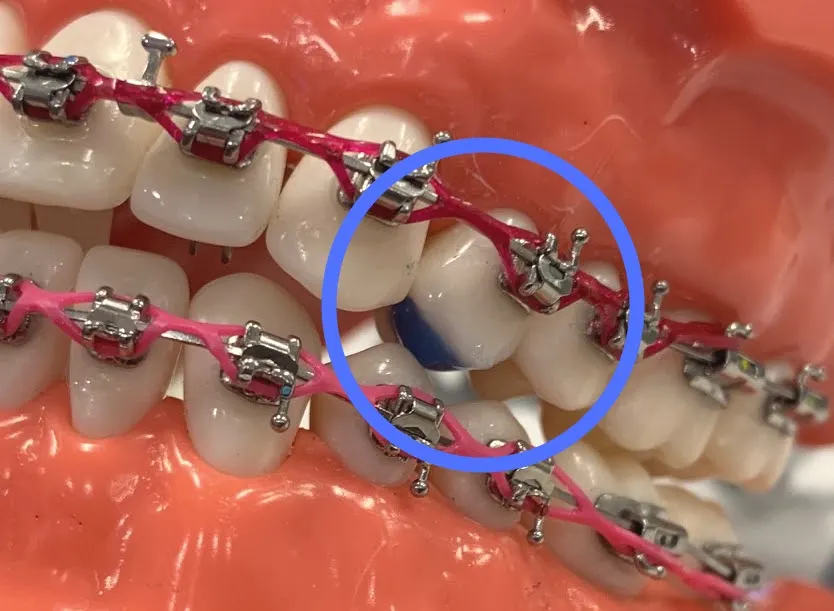
Oftentimes these bite pads will be blue in color to make it easier for removal once braces are completed. You can observe from the photo above that by placing bite pads the patient will no longer need to worry about biting on top of the lower braces. The back teeth are also separated by a small amount; over time, these teeth will gradually drift together.
Placing bite pads on the front teeth and allowing the back teeth to drift together, is usually all that you need to correct a mild deep bite.
These bite pads will typically be placed at the same time as braces and will be removed later on in treatment once the bite is corrected.
With the patient we showed earlier, you can see that braces with bite pads helped to align his teeth correct the overlapping front teeth, and fix the deep bite.



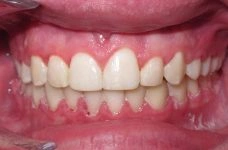
Fixing Moderate Deep Bites With Braces, Rubber Bands, and Bite Pads/Bite Turbos
Moderate deep bites can be corrected using braces, rubber bands, bite pads, or bite turbos. Bite turbos, which are small raised bumps placed on the teeth, can be employed in conjunction with rubber bands to rectify moderate deep bites. These assist in the proper alignment of the upper and lower teeth and safeguard the lower brackets from biting down. Additionally, bite pads or bite blocks can be utilized to prevent contact between the upper and lower teeth, thus reducing the possibility of bracket breakage.
These treatment methods work in concert to gradually rectify the deep bite and enhance the alignment of the teeth. Pursuing orthodontic treatment for moderate deep bites enables patients to avert additional complications and attain a healthier, self-assured smile.
The patient shown in this picture is a good example of a moderate deep bite. You can observe that the top teeth overlap the bottom teeth by a large degree (much more than in our last example).

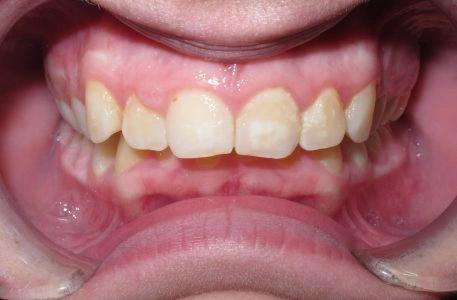
For correcting moderate deep bites, we will use bite pads to separate the back teeth, similar to what was used in the mild deep bite correction. In this case, we will also use elastics to help pull the back teeth together.
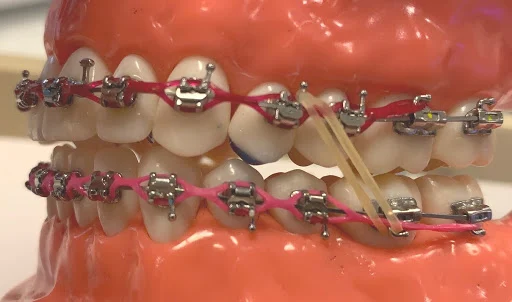
As you can observe in the photo above, the back teeth are not touching when the bite pad is in position. To help these back teeth come together quicker, we will ask the patient to attach a rubber band from the top teeth to the lower teeth in the back. This helps to pull these teeth down and correct the deep bite.
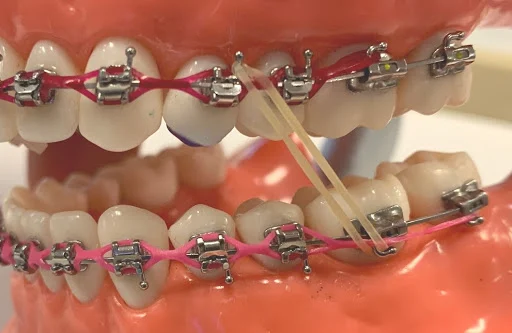
Additionally, if a patient has a more severe deep bite, a “bite turbo” may be used in place of a “bite pad”. Bite turbos are similar to bite pads, but are instead attached to the front teeth.
An example of bite turbos can be viewed in the animation below (please note, the bite turbos used at our office are generally made out of clear dental composite rather than metal as depicted in the animation. We find that the clear dental composite is less noticeable.)
Like bite pads, bite turbos can be used in combination with rubber bands to help correct more moderate or severe deep bites.
In the patient example we showed earlier, he was treated with bite pads, elastics, and braces. This treatment led to a great improvement in his deep bite.



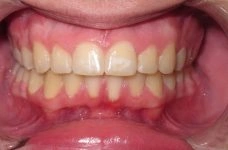
Fixing Severe Deep Bites With Braces, Bite Turbos, and Forsus Springs
For severe deep bites, a combination of braces, bite turbos, and Forsus springs is recommended. Forsus springs help to correct deep bites by pushing the lower teeth forward and down and pushing the top teeth back and up. Bite turbos and Forsus springs are specifically used to address deep bites and overbites by repositioning the teeth and jaw relationship.
The use of braces, bite turbos, and Forsus springs can be beneficial in diminishing the intensity of the deep bite and enhancing the overall bite alignment. Nonetheless, be aware that these treatments may cause pain, discomfort, and possible harm to teeth and gums.
The patient below is a good example:


As you can see from the photos, the top teeth overlap the lower teeth entirely. The top teeth are actually biting on the lower gums, and the lower teeth are biting into the roof of the palate.
Aesthetically this doesn’t look good, but functionally this can cause severe damage to the gum and palatal tissue, as well as damage to the teeth after enough time.
To correct severe deep bites, we usually begin with braces, bite pads or bite turbos, and rubber bands (similar to the moderate deep bite correction). This protocol will get us far in the process of deep bite correction.
But if after this treatment, it’s determined we need more bite correction, we may add a Forsus Spring appliance to help correct the deep bite.
You can see in this animation below exactly how the appliance works.
orsus springs help to correct deep bites by pushing the lower teeth forward and down and pushing the top teeth back and up, thereby correcting the deep bite.
The patient shown before was treated with braces, bite pads, and forsus springs, and you can see the amount of deep bite correction that was achieved because of the treatment.



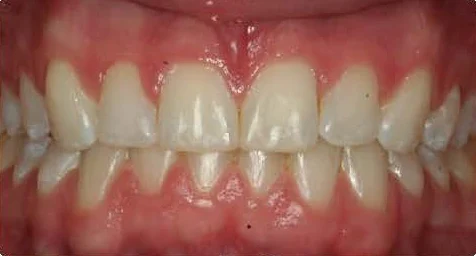
Check out our video below to learn more about how braces helped fix this patient’s deep bite.
Fixing Deep Bites With Invisalign and Clear Aligners
Invisalign and clear aligners can also be utilized to address deep bites, providing a discreet and comfortable treatment solution. Invisalign is a treatment that uses clear, removable aligners to gradually move the upper and lower teeth into the desired bite alignment. Click here to read our article regarding deep bite correction with Invisalign.
Retainers After Deep Bite Treatment
Following deep bite treatment, retainers play a crucial role in maintaining the corrected position of the teeth and preventing orthodontic relapse. Orthodontic relapse occurs when teeth begin to move back to their pre-treatment position after the completion of orthodontic treatment. Retainers help to keep the teeth in their new, adjusted position, preventing a relapse of the deep bite and the necessity for additional orthodontic treatment.
Adhering to your orthodontist’s advice about retainer usage is crucial. Typically, retainers should be worn full-time for the first few months after treatment and then transitioned to nighttime use. Proper retainer care and regular dental check-ups will help maintain your newly corrected smile for years to come.
How Can I Tell if Me or My Child Needs Braces to Fix a Deep Bite?
If you think you or your child may need braces to correct a deep bite, the best place to start is by getting a free consultation with an orthodontist in your area
Braces in Phoenix, Chandler, Maricopa, and Casa Grande
Premier Orthodontics has 6 locations providing braces and Invisalign in Phoenix, Chandler, Gilbert, Maricopa, Casa Grande, and Glendale as well as the surrounding areas.
Schedule your free consultation for braces or Invisalign or read our comprehensive guide to the cost of braces. (We are very transparent about our process and our pricing, as you’ll see in this guide.)
Schedule a Free Braces Consultation For You or Your Child
Thinking about getting started with braces?
You can schedule a 100% free consultation and find out if clear braces the best choice for you.
Whether you’re thinking about braces for kids, braces for an adult, or even Invisalign, we’ve got you covered!
Click below to learn how you can get started with braces for as low as $89/month.
Table of Contents

Dr. Tyler Coles joined his brother’s practice in 2012 and since then, the practice has expanded to six locations and over 20,000 patient lives transformed throughout Arizona.
Dr. Coles has also co-authored two books with his brother ( “More Than Straight Teeth! A Parent’s Guide to Orthodontics” and “Start Smiling Now! What Every Parent Needs to Know About Orthodontics”). Request a free copy of “More that Straight Teeth“ to better understand the process of braces.


